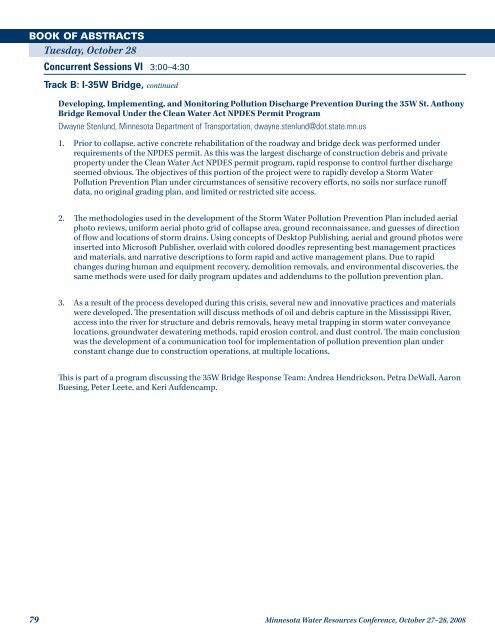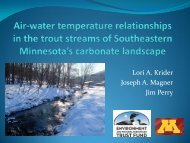Minnesota Water Resources Conference - Water Resources Center ...
Minnesota Water Resources Conference - Water Resources Center ...
Minnesota Water Resources Conference - Water Resources Center ...
You also want an ePaper? Increase the reach of your titles
YUMPU automatically turns print PDFs into web optimized ePapers that Google loves.
BOOK OF ABSTRACTS<br />
Tuesday, October 28<br />
Concurrent Sessions VI 3:00–4:30<br />
Track B: I-35W Bridge, continued<br />
Developing, Implementing, and Monitoring Pollution Discharge Prevention During the 35W St. Anthony<br />
Bridge Removal Under the Clean <strong>Water</strong> Act NPDES Permit Program<br />
Dwayne Stenlund, <strong>Minnesota</strong> Department of Transportation, dwayne.stenlund@dot.state.mn.us<br />
1. Prior to collapse, active concrete rehabilitation of the roadway and bridge deck was performed under<br />
requirements of the NPDES permit. As this was the largest discharge of construction debris and private<br />
property under the Clean <strong>Water</strong> Act NPDES permit program, rapid response to control further discharge<br />
seemed obvious. The objectives of this portion of the project were to rapidly develop a Storm <strong>Water</strong><br />
Pollution Prevention Plan under circumstances of sensitive recovery efforts, no soils nor surface runoff<br />
data, no original grading plan, and limited or restricted site access.<br />
2. The methodologies used in the development of the Storm <strong>Water</strong> Pollution Prevention Plan included aerial<br />
photo reviews, uniform aerial photo grid of collapse area, ground reconnaissance, and guesses of direction<br />
of flow and locations of storm drains. Using concepts of Desktop Publishing, aerial and ground photos were<br />
inserted into Microsoft Publisher, overlaid with colored doodles representing best management practices<br />
and materials, and narrative descriptions to form rapid and active management plans. Due to rapid<br />
changes during human and equipment recovery, demolition removals, and environmental discoveries, the<br />
same methods were used for daily program updates and addendums to the pollution prevention plan.<br />
3. As a result of the process developed during this crisis, several new and innovative practices and materials<br />
were developed. The presentation will discuss methods of oil and debris capture in the Mississippi River,<br />
access into the river for structure and debris removals, heavy metal trapping in storm water conveyance<br />
locations, groundwater dewatering methods, rapid erosion control, and dust control. The main conclusion<br />
was the development of a communication tool for implementation of pollution prevention plan under<br />
constant change due to construction operations, at multiple locations.<br />
This is part of a program discussing the 35W Bridge Response Team: Andrea Hendrickson, Petra DeWall, Aaron<br />
Buesing, Peter Leete, and Keri Aufdencamp.<br />
79 <strong>Minnesota</strong> <strong>Water</strong> <strong>Resources</strong> <strong>Conference</strong>, October 27–28, 2008
















